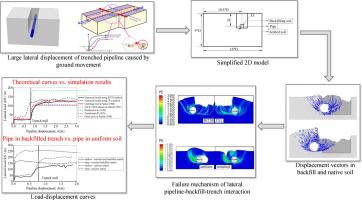Computers and Geotechnics ( IF 5.3 ) Pub Date : 2021-06-21 , DOI: 10.1016/j.compgeo.2021.104307 Xiaoyu Dong , Hodjat Shiri , Wangcheng Zhang , Mark F. Randolph

|
Large lateral displacement of trenched subsea pipelines may be induced by ground movement, landslides, ice gouging, etc. Pre-excavated seabed soil is usually used for backfilling as a cost-effective solution. The large difference between the shear strength of the highly remoulded backfill material and the native soil may significantly affect the pipeline-backfill-trench interaction, the failure mechanisms, and consequently the lateral soil resistance. However, this challenging and less-explored aspect has not been covered thoroughly in design codes. In this paper, the influences of pipeline-backfill-trench interaction on the failure mechanism and resultant lateral soil resistance were investigated by large deformation finite element analyses. Two different methods were considered and compared, including the remeshing and interpolation technique with small strain (RITSS) and coupled Eulerian-Lagrangian (CEL) methods, to assess their relative merits for this problem. A modified Tresca model considering strain-softening effects was incorporated and a parametric study was conducted to investigate the influences of key factors including the trench geometry, stiffness of backfill material, native seabed soil properties, burial depth, and intensity of pipeline-trench bed interaction. The study showed that the ignorance of the pipeline-backfill-trench interaction by using uniform soil may result in underestimation and overestimation of the lateral soil resistance against the pipeline moving inside the backfill and into the trench wall, respectively.
中文翻译:

管道-回填-沟槽相互作用对侧向土阻力的影响:数值研究
地表运动、山体滑坡、冰凿等可能会导致开挖海底管道发生较大的横向位移。预挖的海底土壤通常用于回填,作为一种经济高效的解决方案。高度重塑的回填材料与原生土壤的剪切强度之间的巨大差异可能会显着影响管道-回填-沟槽的相互作用、破坏机制,从而影响侧向土壤阻力。然而,这个具有挑战性和较少探索的方面并没有在设计规范中彻底涵盖。在本文中,通过大变形有限元分析研究了管道-回填土-沟槽相互作用对破坏机制和产生的侧向土阻力的影响。考虑并比较了两种不同的方法,包括使用小应变 (RITSS) 和耦合欧拉-拉格朗日 (CEL) 方法的重新网格划分和插值技术,以评估它们在此问题上的相对优点。引入考虑应变软化效应的修正 Tresca 模型并进行参数研究,以研究关键因素的影响,包括沟渠几何形状、回填材料的刚度、天然海底土壤性质、埋藏深度和管道-沟渠床相互作用强度. 研究表明,由于使用均匀土壤而忽视管道-回填土-沟渠相互作用可能会导致分别低估和高估管道在回填土内和进入沟壁时的横向土壤阻力。评估他们在这个问题上的相对优点。引入考虑应变软化效应的修正 Tresca 模型并进行参数研究,以研究关键因素的影响,包括沟渠几何形状、回填材料的刚度、天然海底土壤性质、埋藏深度和管道-沟渠床相互作用强度. 研究表明,由于使用均匀土壤而忽视管道-回填土-沟渠相互作用可能会导致分别低估和高估管道在回填土内和进入沟壁时的横向土壤阻力。评估他们在这个问题上的相对优点。引入考虑应变软化效应的修正 Tresca 模型并进行参数研究,以研究关键因素的影响,包括沟渠几何形状、回填材料的刚度、天然海底土壤性质、埋藏深度和管道-沟渠床相互作用强度. 研究表明,由于使用均匀土壤而忽视管道-回填土-沟渠相互作用可能会导致分别低估和高估管道在回填土内和进入沟壁时的横向土壤阻力。回填材料的刚度、天然海床土壤特性、埋藏深度和管道-海沟床相互作用的强度。研究表明,由于使用均匀土壤而忽视管道-回填土-沟渠相互作用可能会导致分别低估和高估管道在回填土内和进入沟壁时的横向土壤阻力。回填材料的刚度、天然海床土壤特性、埋藏深度和管道-海沟床相互作用的强度。研究表明,由于使用均匀土壤而忽视管道-回填土-沟渠相互作用可能会导致分别低估和高估管道在回填土内和进入沟壁时的横向土壤阻力。











































 京公网安备 11010802027423号
京公网安备 11010802027423号